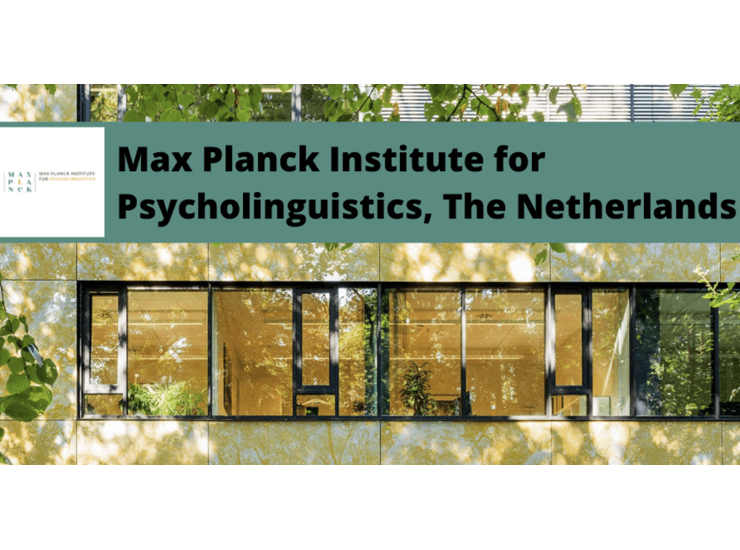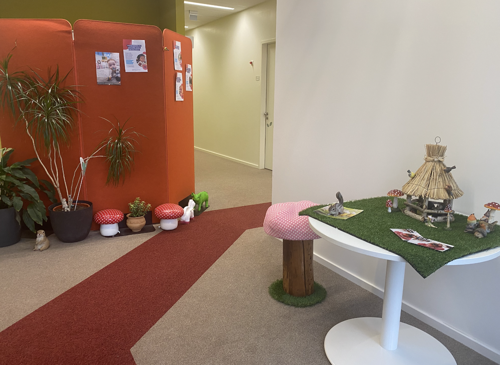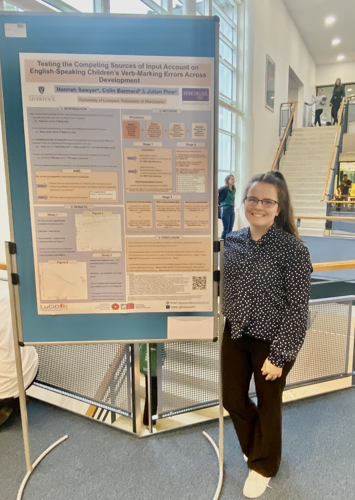
In October 2023, thanks to receiving a LuCiD travel grant, I was lucky enough to spend a week at the Max Planck Institute (MPI) for Psycholinguistics in Nijmegen. The aim of this trip was to visit Professor Caroline Rowland and her team in the Language Development Lab, and to learn more about how research is conducted there.
After arriving in Nijmegen, I managed to successfully navigate my way through Goffert Park to the MPI without getting run over by a bicycle. Now, if you have ever been to Nijmegen or anywhere in the Netherlands, you will know what an achievement that is. I was greeted with the (less dangerous) woodland fairy trail set up for children which welcomes them into the Child Language Lab (see Picture 1). I thought this was a great idea as it provides researchers with ample opportunity to break the ice with their participants as well as make the lab not seem such a scary place for young children.

While I was there, I managed to take part in some of their cognitive control/executive function games. These types of games are used to measure interference that occurs in the brain, especially when trying to process something when one feature of it hinders the processing of a second simultaneous feature. For example, I participated in the “day and night” game which asks children to say the word “day” when they see a picture of a moon, and “night” when they see a picture of the sun. This is, of course, in the opposite direction to what you would expect or want to say and is a lot harder than it sounds. In fact, I’m sure that some of their young participants performed better than me.
During my week-long visit, I was also able to meet with some of the research assistants and post docs who work at the MPI and find out more about what they are doing. One study which I found fascinating was research on bimodal infants – these are infants who experience spoken language input from one parent and sign language input from another. Since we know that infants learn the meaning of words from their experiences of real-time interactions with their caregivers, the aim of this study is to see how bimodal children’s interactions affects their word learning. Specifically, these researchers want to see where these children focus their attention when they are learning names for novel objects in sign language compared to those who only receive spoken language input. To do this, they are using head-mounted eye trackers which show where the children are looking when the novel label is being presented. While this population is hard to recruit, luckily the MPI have their own testing bus which means they can go further afield when recruiting participants and ensures that participants are all still tested in the same controlled environment.
Finally, being at the MPI in the last week of October allowed me to take advantage of the Many Paths to Language (MPAL) conference that was running at the same time. I had the opportunity to present some of my PhD work: a poster entitled “Testing the Competing Sources of Input Account on English-Speaking Children’s Verb-Marking Errors Over Development” (see Picture 2).

This poster described a corpus study conducted with Julian Pine and Colin Bannard which looked at how the input that children receive from their caregivers affects their language development. We know that children are more likely to produce words that occur frequently in their caregiver’s speech, but do highly frequent words or phrases also cause them to make errors? In this study, we focused on verb-marking errors which is when children do not use the appropriate form of a verb, such as in “She play(*s) football” (where they have not produced the third person singular -s) and “Daddy (*is) singing” (where they have not produced the auxiliary “is”). We used a corpus analysis of children’s naturalistic speech to test the idea that children make verb-marking errors because they extract unmarked sequences from longer structures in the input. For example, children may extract the sequence “She play” from “Does she play football?” or “Daddy singing” from “I can hear Daddy singing”. Data from 12 2- to 3-year-olds from the Manchester corpus and 12 3- to 4-year-olds from the Post-Manchester corpus were coded for verb-marking errors (e.g., Baby go in there) and correct uses (e.g., Baby goes in there). We investigated how different input statistics calculated form the adult speech in a large number of corpora (such as the relative frequency of subject+verb sequences in the unmarked form, and the relative frequency of verbs in the unmarked form) influenced these errors and whether they remained stable over development. We found that children’s errors are related to the relative frequency of both sequences and verbs in the unmarked form in the input, but that the effects of unmarked verbs dropped out first. Overall, these results showed that children’s errors can be directly related to the input that they hear and that children can recover from these errors by becoming more sensitive to the preceding context. For more information on this study, you can see the preprint here.
I would just like to end this blog with another thanks to LuCiD for awarding me with this travel grant, and to Professor Caroline Rowland and everyone else at MPI for having me.

